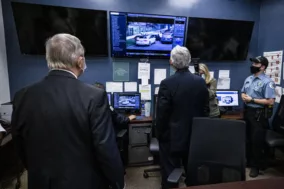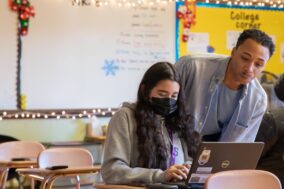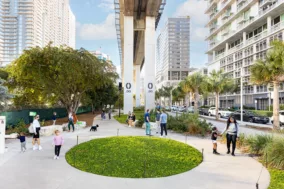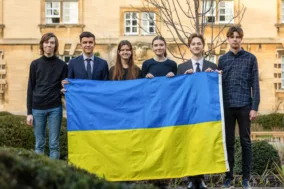Closing the Digital Divide
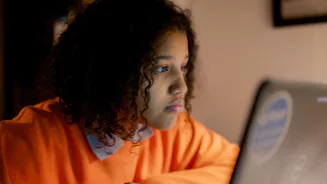
- During the COVID-19 pandemic, public school closures forced students across Chicago to adapt to online learning, but more than 110,000 had no access to the internet at home.
- With a leadership gift of $7.5 million, Griffin Catalyst helped convene a diverse group of policymakers and funders to bring free, fast internet to low-income families across the city.
- After being replicated in Miami with the support of Griffin Catalyst, this approach served as a model for other cities across the U.S. and Canada. The federal Affordable Connectivity Program builds on this work, connecting over 17.1 million American households to low-cost internet so far.
With ongoing access, every student and their family – regardless of economic circumstance – will be better positioned to pursue a brighter future. I hope Chicago Connected will inspire other communities across the country to come together to eliminate the digital divide.
In the early months of 2020, as COVID-19 swept across the globe, a Chicago-based education organization, Kids First Chicago, sounded the alarm bell.
Along with the city’s stores, restaurants, and theaters, Kids First Chicago realized that Chicago’s public schools were likely to shut down, too—with potentially devastating consequences for the city’s most vulnerable students.
Since 2015, Kids First Chicago had been providing a platform for parent engagement in the city’s sprawling public school system and using data to understand and elevate the concerns families had shared. Even before the pandemic, it had become clear that there was a vast gap in access to the internet—a “digital divide”—between Chicago’s low-income households and the rest of the city.
Some households did not have computers. Others had no internet infrastructure. Many had the infrastructure but could not afford the monthly fees for at-home internet. While other children completed their online homework in the comfort of their bedrooms, kids experiencing this digital divide had to use Wi-Fi wherever they could find it—a public library, a Starbucks, the parking lot of a McDonald’s.
In April 2020, what had been a simmering problem was fast becoming a full-blown crisis. Conducting a citywide assessment with census data, Kids First Chicago estimated that one out of five students in Chicago were without internet. If the pandemic forced schools to close, those children would be getting no education at all—for days, months, or perhaps years.
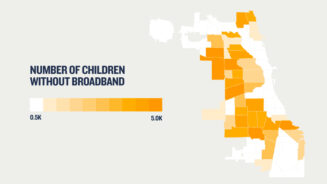
Michelle and I are happy to help Chicago Connected reach every kid in the city. This is where I found a purpose and a family—and it’ll always be our home.
With the shutdown looming and time running short, Ken Griffin and the team at Griffin Catalyst stepped in. The team encouraged Kids First Chicago to develop a plan to tackle the digital divide and approached the Mayor’s Office and the school district about what might be possible with philanthropic funding. Within a matter of weeks, Chicago Connected was born.
In addition to committing $7.5 million, Griffin Catalyst helped convene a diverse group of funders to support the initiative, from the Crown Family Philanthropies and Chicago Community Trust to Penny Pritzker’s Pritzker Traubert Foundation and the MacArthur Foundation. Soon, former President Barack Obama and former First Lady Michelle Obama joined in, personally contributing to the groundbreaking effort underway in their hometown.
Even in this moment of crisis, Griffin Catalyst looked to the long term. Its support helped to cover free internet access for the household of every qualified child for two full years—on the condition that in the third and fourth years of the program, the city government would pick up the full cost and carry it forward for the children of Chicago.
Providing High-Speed Internet Access To More Homes
It was moving so fast, but it was not going to get over the finish line until Ken Griffin showed up and said, ‘We’ll pick up part of this tab.’ It felt like a million years to get it off the ground, but when I look back—we started from zero and it took two months.
On June 25, 2020, observing that “internet connectivity is a lifeline to education and opportunity,” Ken Griffin announced his support of Chicago Connected. Working closely with Hal Woods and Daniel Anello of Kids First Chicago, Chicago’s Chief Financial Officer Jennie Bennett and then Chief Information Officer for Chicago Public Schools Phillip DiBartolo, the team launched what would soon become the largest public-private partnership devoted to closing the digital divide in any city, anywhere.
Chicago Connected proves that we can solve big problems—when we partner and listen to those most impacted.
The results were extraordinary. Internet access allowed students to engage with remote learning to continue their education as best they could. But it did more than that. Quarantined families were using their new internet service to look for employment opportunities, learn about social services, and—crucially, in that frightening and challenging time—obtain critical health care information about COVID-19 prevention and ultimately, vaccines.
100,000+
Students provided with broadband internet, including nearly 1 in 3 Chicago Public School students
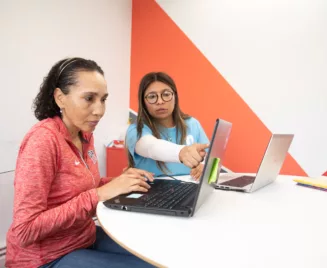
As the pandemic stretched on and daily routines moved onto screens, access to the internet became even more of a critical connection to the larger world, and Griffin Catalyst is proud to have helped Chicago Connected extend that “lifeline,” in Ken Griffin’s words, to students and families across the city.
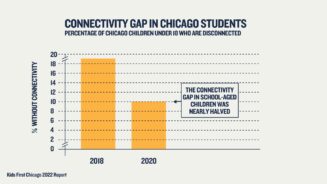
Chicago, of course, was just one of countless communities struggling with the digital divide during the pandemic. Seeing the opportunity to bring the same kind of public-private partnership for online access to more places, Griffin Catalyst proposed replicating the Chicago Connected program in Miami.
In spite of its reputation as an emerging tech hub, Miami ranked among the least-connected cities in America. At the time, 297,000 Miami households lacked access to broadband internet—33% of all households in the city.
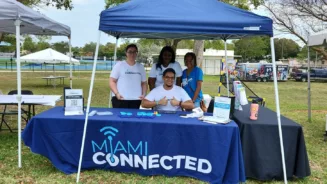
There, Griffin Catalyst’s $5 million leadership grant spearheaded a $30 million effort—Miami Connected—developed with Miami Mayor Francis Suarez, Miami-Dade County Mayor Daniella Levine Cava, and nonprofit partners, including Achieve Miami and The Miami Foundation. Since launching, through direct service and leveraging federal resources, the program has served more than 300,000 people, an effort Mayor Suarez has called “really game-changing for us.”
A recent report on the program’s impact observed that 91% of Miami families say their internet service is faster and more reliable, and 89% of those families are using their improved service to pursue educational and economic opportunities. “Thanks to having internet service again, I have been able to re-enroll in online classes as well as start an online business that I can run from home,” said Makeida , who’s benefited from the program. “These opportunities for additional income go a long way for a single parent like myself.”
Amidst a global crisis, a new approach to bridging the digital divide had been born—and as the pandemic raged on, cities from Oakland to Philadelphia to Toronto would look to the Chicago and Miami programs as a model for their own communities.
300,000+
People connected to at-home internet through the work of Miami Connected
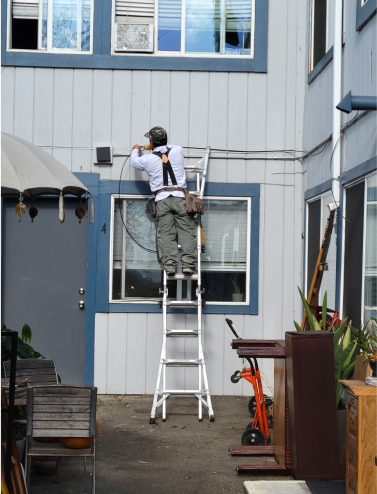
To build on this momentum, Griffin Catalyst pivoted toward national efforts to close the digital divide, helping to fund EducationSuperHighway’s work to address the affordability gap for the 18 million households in America that have internet access but cannot afford to connect. In the nation’s most unconnected communities—nearly always low-income—more than a quarter of homes have no internet.
Now, change is well underway—and at scale. In November 2021, President Joe Biden, with bipartisan support, signed into law $14 billion in federal funding to address the digital divide by creating the Affordable Connectivity Program. The president extended that effort in May 2022 when he announced that 20 of the country’s largest internet companies, including AT&T, Comcast, and Verizon, had agreed to provide affordable service to millions of low-income families.
“High-speed internet service is no longer a luxury,” the president declared, in words that echoed Daniel Anello’s urgent original call to action. “It’s a necessity.”
17.1 Million
American households who couldn’t afford to connect to broadband internet have gained access through the Affordable Connectivity Program

